The box of cornflakes sitting in your kitchen may have never prompted much thought, but those little flakes hold a fascinating history. Among other things, a persistent rumor has been circulating that the popular breakfast cereal was invented as an anti-masturbatory aid.
As usual, the truth isn’t quite as strange, but there is still a remarkable story behind the invention of cornflakes, and—dare we say—a grain of truth to the anti-masturbation rumor, as well!
Who invented cornflakes?
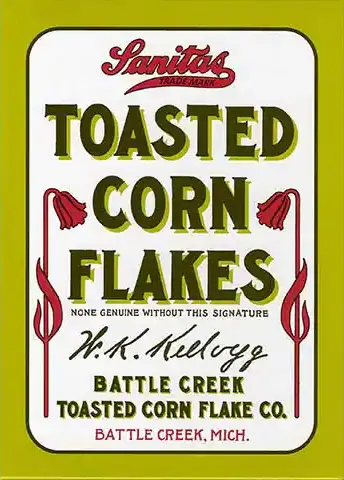
There is some disagreement as to who actually invented cornflakes. Whereas the 1896 patent says John Harvey Kellogg, a 1921 court ruling gave the credit to his brother, Will Keith Kellogg.
In truth, both brothers worked together to develop the breakfast cereal, which first hit the shelves in 1898, under the cumbersome brand-name “Sanitas Toasted Corn Flakes.” However, the product didn’t find a lot of commercial success as it quickly turned rancid while not tasting quite good either.
For reasons such as these, in 1906, Will Keith proposed adding sugar to the mix, which his health-conscious brother refused to do. The disagreement led to the brothers going their separate ways and Will Keith setting up his own company, the Battle Creek Toasted Corn Flake Company, which later became the Kellogg’s we know today.
The 1921 court ruling, which gave Will Keith all the credit for inventing cornflakes, was actually not about who invented them, but rather about trademark infringement. This ruling was made in favor of Will Keith, as the court found that he was the rightful owner of the trademark “Kellogg’s”.
John Harvey Kellogg
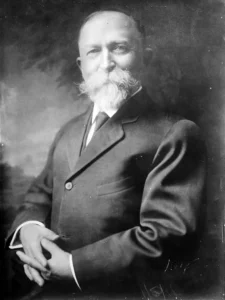
Even though business-savvy Will Keith was obviously the better marketer, it’s actually his brother who’s the more interesting figure of the two, both historically and in terms of our story.
Born in 1852, Dr. John Harvey Kellogg was a man of many hats. In addition to being a medical doctor and health-food innovator, he was also a noted philanthropist, a staunch advocate of vegetarianism, an early proponent of the germ theory of disease, and—quite controversially—a noted eugenicist.
Well ahead of his time in terms of his medical and dietary beliefs, Dr. Kellogg was a prolific author and public speaker. Most famously, he was the mastermind behind the success of the Battle Creek Sanitarium, a world-renowned health resort which he ran for most of his life, and where many of his ideas were first implemented.
The Battle Creek Sanitarium
The Battle Creek Sanitarium was founded in 1866 as Western Health Reform Institute, on health principles newly advocated by the developing Seventh-Day Adventist Church (SDA).
For the first decade of its existence, the Institute struggled financially, as its medical staff “failed to inspire the public with confidence.” That all changed in 1875, when John Harvey Kellogg—a recent graduate of Belleview Hospital Medical College, New York City—joined the staff, brimming with progressive ideas and contagious enthusiasm.
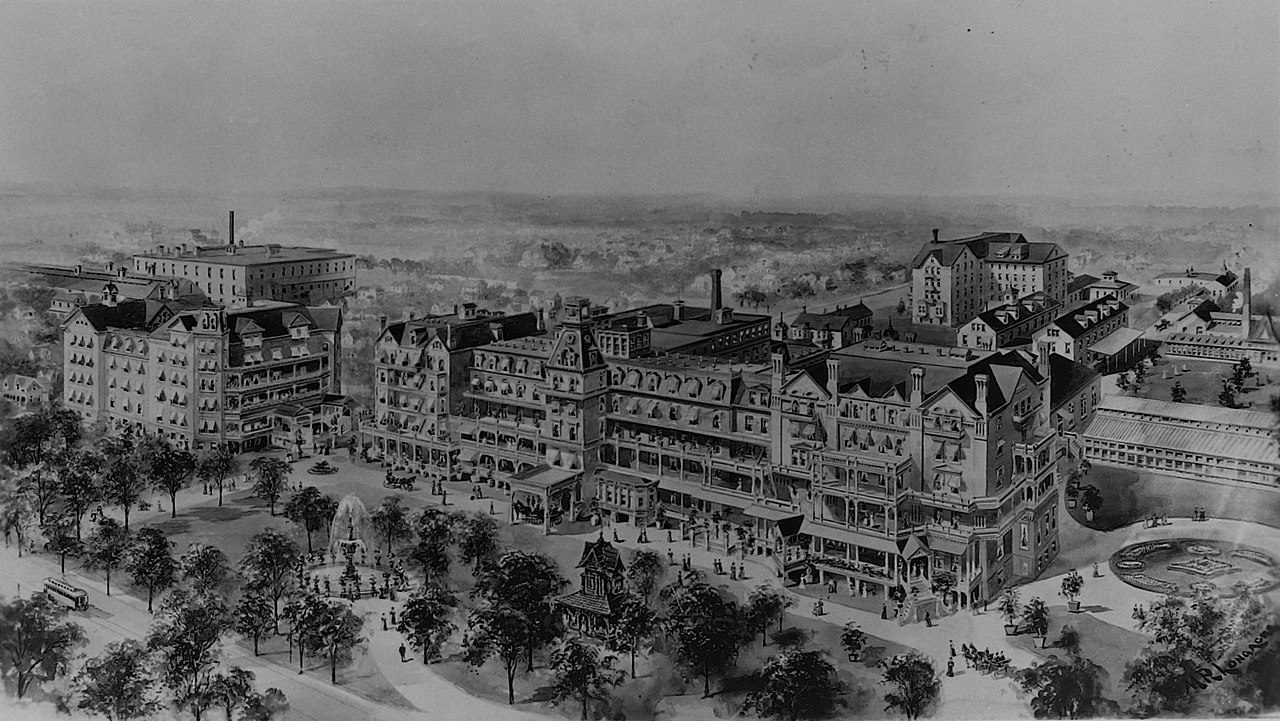
The very next year he was appointed medical superintendent of the institute, which he soon renamed it the Battle Creek Medical Surgical Sanitarium. Under the leadership of John Kellogg, the Sanitarium (or “the San” as it was often called) grew into one of the most fashionable health resorts of its time.
Operating under the health beliefs of the SDA church, it became world-famous for its innovative treatments, which included the use of hydrotherapy, thermotherapy, electrical stimulation, massage, physical exercise, and a lot of rest.
Within a decade, the San more than quadrupled its patient load (going from 300 to 1,200), while becoming a popular destination for the rich and famous, including celebrities such as Henry Ford, Amelia Earhart, John D. Rockefeller, and Johnny Weissmuller.
But what does it all have to do with masturbation?
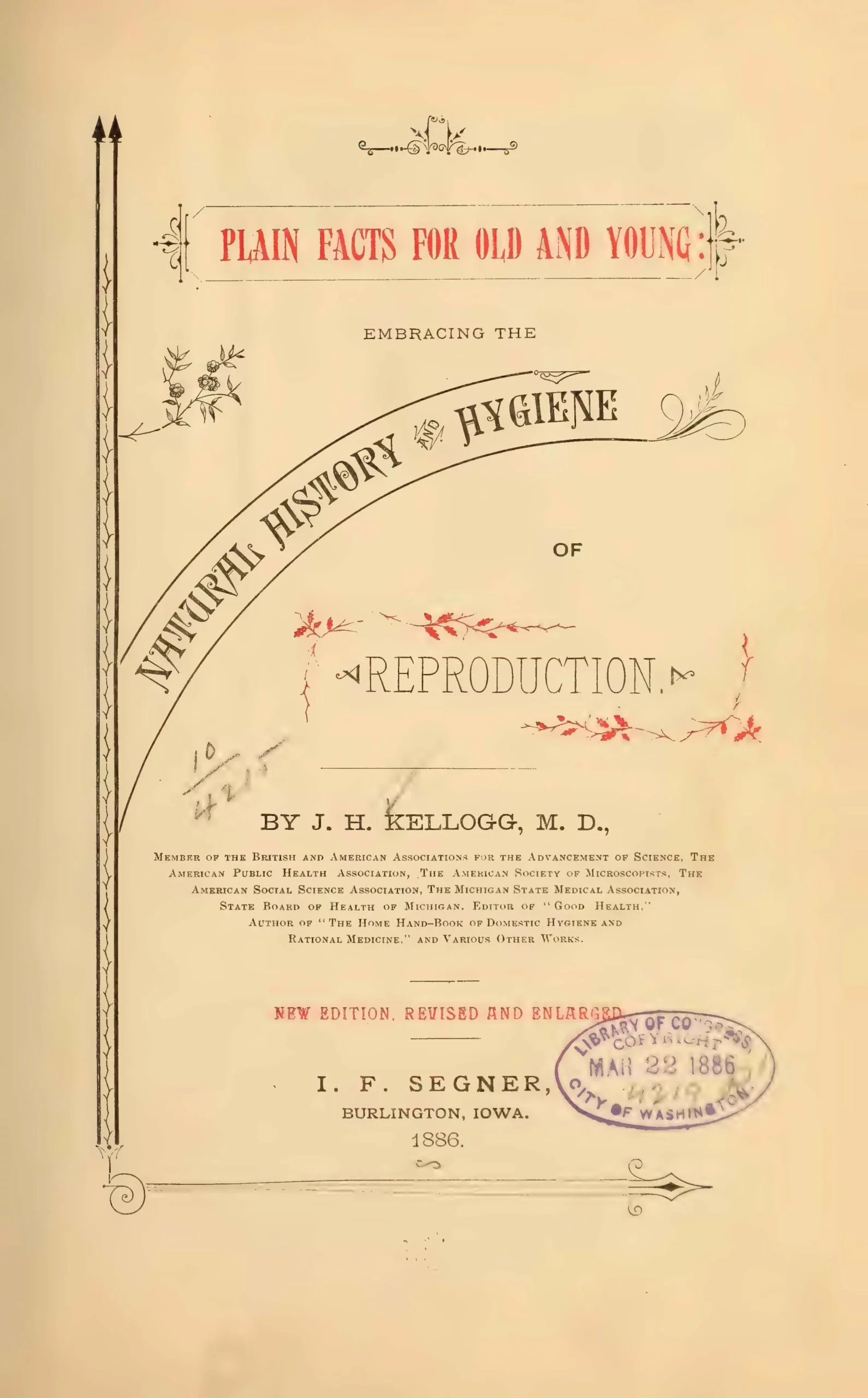
During his seven-decade tenure as the San’s superintendent, Kellogg remained a staunch believer in certain lifestyle choices, and how they affected both physical and spiritual wellbeing.
In addition to promoting clean living and a strict vegetarian diet, he was also a loud advocate of life-long abstinence from certain (as he termed them) vices, such as alcohol, tobacco, and caffeine. And, well, masturbation. Especially masturbation.
You see, Kellogg believed that stiff joints, mood swings, acne, and even epilepsy could be all attributed to the act of self-gratification. In his book, Plain Facts for Old and Young: Embracing the Natural History and Hygiene of Organic Life, Kellogg wrote that masturbation is “a dreadful sin,” better referred to as “self-abuse” or “self-pollution.” If you think that’s harsh, just wait till you hear the rest:
The sin of self-pollution is one of the vilest, the basest, and the most degrading that a human being can commit. It is worse than beastly. Those who commit it place themselves far below the meanest brute that breathes. The most loathsome reptile, rolling in the slush and slime of its stagnant pool, would not bemean itself thus. It is true that monkeys sometimes have the habit, but only when they have been taught it by vile men or boys. A boy who is thus guilty ought to be ashamed to look into the eyes of an honest dog.
Treating “the solitary vice”
For Kellogg, masturbation was “the most dangerous of all sexual abuses, because the most extensively practiced.” Bemoaning its “alarming prevalence,” he sought different ways to discourage the practice, advocating for cold baths, cool enemata, electrical shocks, circumcisions and—most relevantly for our article—dietary restrictions.
Kellogg believed that one of the best ways to combat “the solitary vice” and its detrimental effects was to eat a relatively bland diet. His view was that stimulating foods and drinks affected the mind and body negatively, making sexual urges harder to fight. He even went as far to state that “a man that lives on pork, fine-flour bread, rich pies and cakes, and condiments, drinks tea and coffee and uses tobacco, might as well try to fly as to be chaste in thought.”
In place of such articles, Kellogg promoted the consumption of plain foods. “Eat fruits, grains, and vegetables,” he wrote. “There is a rich variety of these kinds of food, and they are wholesome and unstimulating. Graham flour, oatmeal, and ripe fruit are the indispensables of a dietary for those who are suffering from sexual excesses.”
But it wasn’t just about masturbation
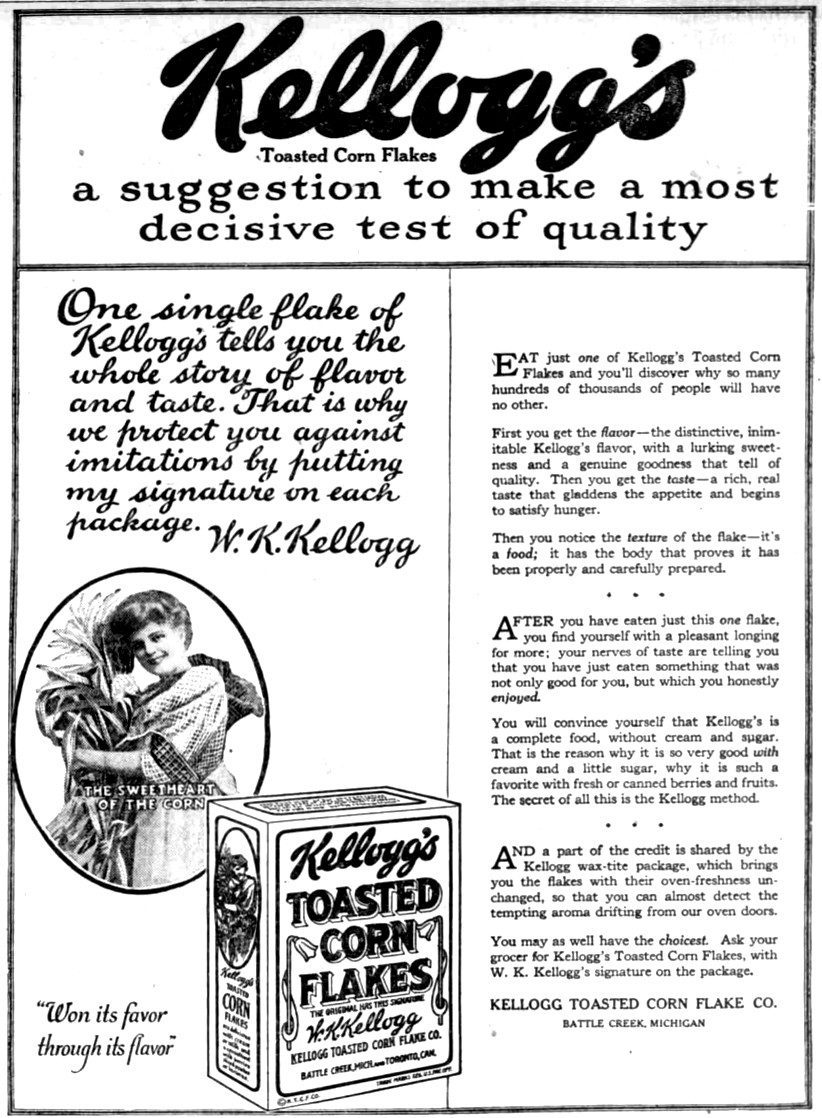
It was Kellogg’s belief in the power of deliberately bland food to fight sexual excess—and especially the sentence just quoted—that spurred on the idea that cornflakes were invented to fight off the urge to masturbate.
However, despite his widely known—and loudly advocated—beliefs, there’s no evidence to suggest that Kellogg invented cornflakes specifically as a means of controlling people’s sexual urges. He was, after all, a progressively-minded doctor, deeply interested in health and nutrition, and cornflakes were just one of his many health food experiments, all invented as a way to provide a healthy and nutritious breakfast.
So, even though he indeed believed that avoiding certain foods—such as those that were overly sugary or spicy—could help people control their urges, there’s no evidence to support the claim that cornflakes were invented to fight off the urge to masturbate.
Not unlike paleo
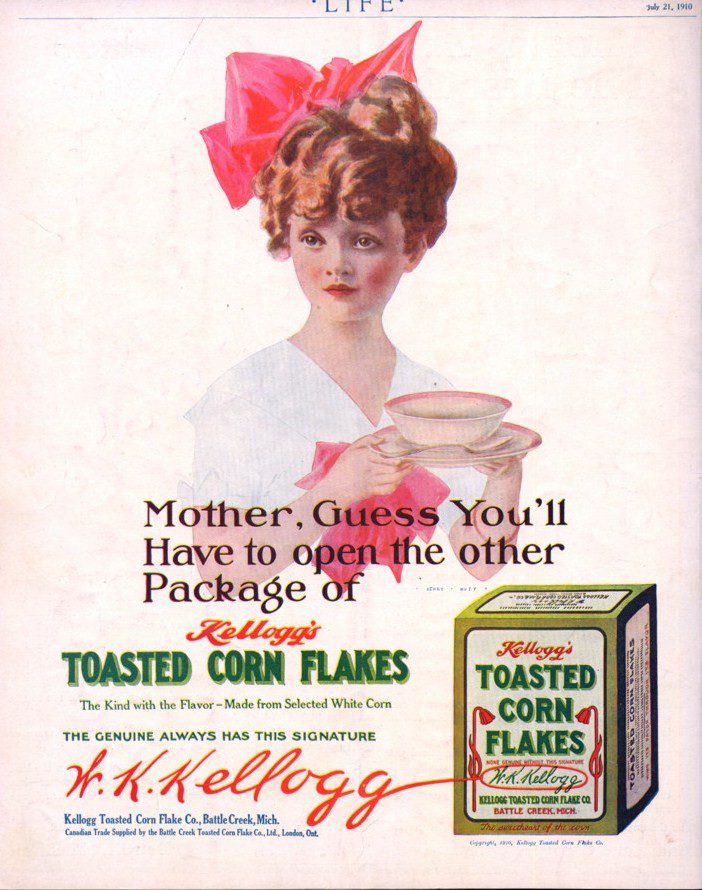
Kellogg’s views on bland diets related to more than just sex, and his frustration at the steady increase in heavy and hard-to-prepare food prompted him (and his brother) to try and create a simple, easy-to-digest breakfast meal. He aimed to counter indigestion while also sticking to the Seven-Day Adventist Church rules of vegetarianism.
In retrospect, his dietary stance wasn’t unlike a modern day paleo diet, with a strong emphasis on whole grain foods, keeping meals as simple as possible for easy digestion. Kellogg was one of the very first nutritionists to become aware of how much time and effort went into food preparation, yet how many problems emerged from the foods being eaten.
Diarrhea, indigestion, bloating, and upset stomachs were extremely common at the San, and Kellogg wanted something to help counter this. That’s how cornflakes were born. In other words, the flaked cereal process was primarily developed as a way of making food more easily digestible—and that’s precisely how the product was usually marketed at the beginning.
The patent says nothing about masturbation
When the patent for Kellogg’s cornflakes was first listed in 1896, it included no mention of the recipe being a deterrent to sexual urges—it focused solely on the health benefits of bland and easily digestible foods. In Kellogg’s words:
My invention relates to an improved alimentary product and to the process of making it; and the object of the improvement is to provide a food product which is in a proper condition to be readily digested without any preliminary cooking or heating operation, and which is highly nutritive and of an agreeable taste, thus affording a food product particularly well adapted for sick and convalescent persons.
Regardless of any overarching beliefs, this is generally accepted as definitive proof that the cereal was not intended (or, at least not directly) as an anti-masturbatory morning meal.
So how did the anti-masturbatory rumor start?
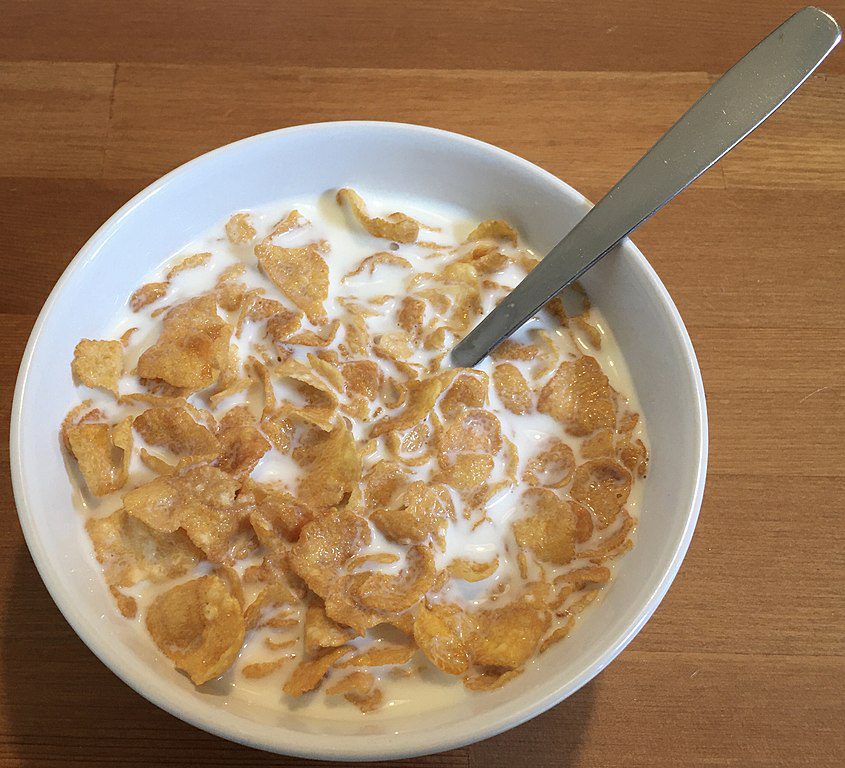
Simply put, the internet did all the grunt work.
As Snopes and other fact-checking sites have pointed out, it all began in 2012, with an otherwise-praiseworthy Mental Floss article, which claimed that Kellogg “developed a few different flaked grain breakfast cereals—including corn flakes—as healthy, ready-to-eat, anti-masturbatory morning meals.”
Six years later, an Australian news website picked up that last part of the sentence, claiming that “Mr. Kellogg, the man who created Corn Flakes, produced the cereal in the late 19th century and marketed it as a ‘healthy, ready-to-eat anti-masturbatory morning meal.'”
This sentence—or, more specifically, those wrongly placed quotation marks—quickly took on a life of its own, spreading misinformed rumors about the supposed anti-masturbatory properties of cornflakes.
To this day, a version of the rumor persists, despite the fact that it’s entirely false. But then again, what might one expect in a world where Hitler invented blow-up dolls while Elon Musk and hundreds of thousands of his followers believe that, somehow, “the most entertaining outcome is the most likely“?


